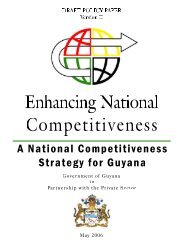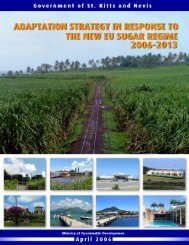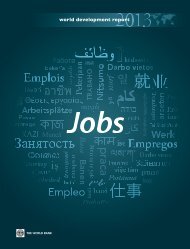Business Removing
Doing Business in 2005 -- Removing Obstacles to Growth
Doing Business in 2005 -- Removing Obstacles to Growth
- No tags were found...
You also want an ePaper? Increase the reach of your titles
YUMPU automatically turns print PDFs into web optimized ePapers that Google loves.
ENFORCING CONTRACTS 63<br />
What to reform?<br />
Doing <strong>Business</strong> in 2004 identified 4 types of reform that<br />
have improved dispute resolution:<br />
• Establishing information systems in the courts.<br />
• Taking transactions that are not disputes, such as<br />
business registration, out of the judges’ hands.<br />
• Reducing procedural complexity.<br />
• Establishing small-claims courts and specialized<br />
commercial courts.<br />
TABLE 8.2<br />
Popular reforms in 2003<br />
Establish judicial statistics<br />
systems<br />
Remove nondisputes from<br />
judges’ hands<br />
Introduce summary proceedings<br />
Establish small claims courts<br />
Source: Doing <strong>Business</strong> database.<br />
Argentina, Bulgaria, Finland,<br />
Germany, Mexico, Slovakia<br />
Germany, Honduras, Nicaragua,<br />
Serbia and Montenegro, Slovakia<br />
Bosnia and Herzegovina, Finland,<br />
Lithuania, Portugal, Philippines<br />
Israel, Lao PDR, Norway<br />
Some of these reforms have a long history. In England<br />
the first comprehensive report on caseloads and<br />
judicial statistics came out in 1851. Sixty reports have<br />
followed since. 8 More countries have taken up reforms<br />
recently (table 8.2). Germany developed a case tracking<br />
system for staff planning in the judiciary. 9 Bulgaria also<br />
introduced such a system in all of its district courts. Serbia<br />
and Montenegro recently took business registration<br />
out of the courts. In Germany and Slovakia registration<br />
is still in the courts, but court clerks rather than judges<br />
are now responsible for it. Bosnia and Herzegovina, Finland<br />
and Lithuania simplified proceedings by making<br />
the rules on presenting evidence more flexible. Streamlined<br />
procedures for small claims were established in Israel,<br />
Lao PDR and Norway.<br />
Russia illustrates the benefits of reform. Within a year<br />
after the introduction of the summary procedure in late<br />
2002, 60% of debt collection cases in Moscow used the<br />
new procedure, and about a third of cases in Novosibirsk<br />
and Saratov. A summary procedure typically takes 2<br />
months from start to finish, 9 months less than the general<br />
procedure. 10 The head of the commercial court in<br />
Moscow notes that “the procedure is shorter and simpler,<br />
and can take place without holding a judicial hearing,<br />
only on the basis of written documents. This procedure is<br />
permitted when the parties have no objections to it. For<br />
example, an energy supplier isn’t paid. The business says it<br />
has no money. Where is the dispute? Everything is clear.<br />
But before [the reform] we handled such cases according<br />
to the general procedure which is complicated. Now the<br />
time of judge is freed up to resolve more difficult cases.” 11<br />
The federal district court of Mexico City analyzed<br />
judicial statistics before introducing reform. The judiciary<br />
had complained of a shortage of judges to handle<br />
the ever-increasing number of cases and asked for additional<br />
resources. In 2002 the Secretaria de Hacienda<br />
Credito y Publico commissioned a study on the profile<br />
of users of commercial dispute resolution, the typical<br />
duration and cost of debt recovery cases and the likely<br />
outcome. 12 The results surprised everyone: 60% of cases<br />
never moved beyond the initial filing: of those that did<br />
half were abandoned before reaching judgment. So while<br />
Mexican judges claimed overload, in reality they dealt<br />
with only 1 in 5 cases. 13 Once this adjustment is made,<br />
the data show that the average Mexican judge handles<br />
fewer cases than judges in Colombia and Ecuador. Instead<br />
of hiring more judges, the government can spare<br />
money for other uses.<br />
Three other reforms have proven successful in the<br />
past year:<br />
• Introducing case management.<br />
• Reducing abuse of appeals.<br />
• Providing better incentives for enforcement.<br />
Introducing case management<br />
Case management—when the judge follows the case<br />
from start to end—received international attention after<br />
Lord Woolf’s Access to Justice in England and Wales report<br />
came out in 1995, though reforms to introduce it in Australia,<br />
Canada and Hong Kong (China) were already ongoing.<br />
14 The report was concerned with the rapidly rising<br />
expenditures on legal aid. At the same time, surveys of<br />
users consistently indicated a high level of dissatisfaction<br />
with the courts. After reviewing several thousand cases,<br />
Lord Woolf recommended judicial case management as<br />
the main way to increase access to justice. British courts<br />
reformed accordingly. The idea has also sparked reforms<br />
in India, Malaysia, New Zealand and Uganda. 15<br />
By now there is ample evidence to show that case<br />
management in the courts reduces delays and increases<br />
user satisfaction in rich, middle income and poor countries<br />
alike. The average duration of debt collection is 5<br />
months in rich countries where judges actively manage

















